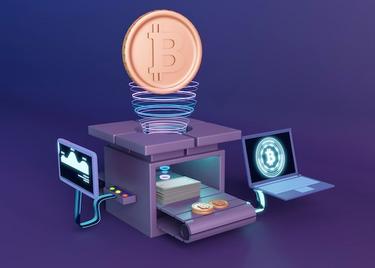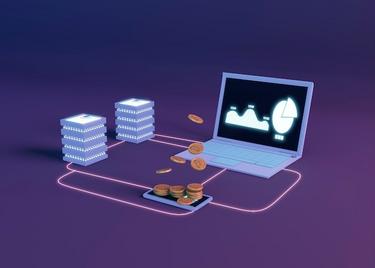An alternative to fiat currency
Cryptocurrencies[1] have emerged as a significant alternative to traditional fiat currencies, offering a digital, decentralized, and secure means of conducting transactions. Unlike fiat currencies, which are issued and regulated by governments, cryptocurrencies operate on a peer-to-peer network, leveraging blockchain[2] technology to ensure transparency[3] and immutability[4] of transactions.
- Comparison with Fiat Currency
- Advantages over Fiat Currency
- Challenges and Considerations
- The Future of Currency
- An alternative to fiat currency
- Cryptocurrencies: The Digital Frontier
- Stablecoins: Bridging Fiat and Crypto
- Central Bank Digital Currencies (CBDCs): The State’s Answer
- Digital Gold: Precious Metals in the Digital Age
- Community Currencies: Local Solutions to Global Problems
- Barter Networks: The Oldest Form of Exchange Reimagined
Comparison with Fiat Currency
Cryptocurrencies differ from fiat currencies in several key aspects:
- Decentralization[6]: Unlike fiat currencies, most cryptocurrencies are not controlled by any central authority.
- Digital Nature: Cryptocurrencies exist only in digital form, making them inherently suited for the digital age.
- Supply Control: The supply of many cryptocurrencies is limited by design, contrasting with the potential for fiat currencies to experience inflation[7].
Advantages over Fiat Currency
Cryptocurrencies offer various advantages over fiat currency, including lower transaction fees, faster international transfers, enhanced security through cryptography[8], and financial inclusivity for those without access to traditional banking systems.
Challenges and Considerations
Despite their potential, cryptocurrencies face challenges as an alternative to fiat currency, including price volatility[9], regulatory uncertainty[10], and the need for broader adoption and understanding.
The Future of Currency
As digital technologies continue to evolve, cryptocurrencies may play an increasingly prominent role in the global economy, potentially complementing or even replacing traditional fiat currencies in some contexts.
An alternative to fiat currency
In the evolving landscape of global finance, the quest for alternatives to traditional fiat currencies has gained momentum. Driven by the desire for more inclusive, transparent, and efficient financial systems[11], various forms of digital currencies[12] and assets have emerged. These alternatives aim to address the limitations of conventional fiat currencies, such as inflation, transaction fees, and the need for intermediaries. This exploration of non-fiat alternatives is not just an academic exercise but a practical response to the changing dynamics of global economics, technology, and societal needs.
Cryptocurrencies: The Digital Frontier
Cryptocurrencies, such as Bitcoin[13] and Ethereum[14], are perhaps the most well-known alternatives to fiat currency. Built on blockchain technology, these digital currencies offer decentralized, peer-to-peer transactions without the need for central banks or financial institutions. The cryptographic security measures and distributed ledger[15] system underpinning cryptocurrencies ensure transparency and immutability of transactions, appealing to users seeking autonomy and privacy in their financial dealings.
Stablecoins: Bridging Fiat and Crypto
Stablecoins represent a hybrid approach, combining the stability of fiat currencies with the technological benefits of cryptocurrencies. Pegged to stable assets like the US dollar, gold, or a basket of currencies, stablecoins aim to minimize the volatility typically associated with cryptocurrencies. This stability makes them an attractive medium for daily transactions, remittances, and a safeguard against the inflationary tendencies of some fiat currencies.
Central Bank Digital Currencies (CBDCs): The State’s Answer
In response to the proliferation of digital currencies, several central banks are exploring or implementing their own digital currencies, known as Central Bank Digital Currencies (CBDCs). CBDCs are digital forms of fiat money, issued and regulated by the nations’ central banks. They aim to provide the advantages of digital currency[17] technology—such as efficiency, lower transaction costs, and enhanced financial inclusion[18]—while maintaining state control over monetary policy and financial stability[19].
Digital Gold: Precious Metals in the Digital Age
Digital gold and other tokenized precious metals offer another alternative to fiat currency. These digital assets represent ownership of a physical quantity of gold or other metals, combining the intrinsic value and stability of precious metals with the liquidity[20] and transferability of digital assets. This blend appeals to those looking for a hedge against inflation and currency devaluation, without the logistical challenges of storing and transporting physical metals.
Community Currencies: Local Solutions to Global Problems
Community currencies are localized or niche alternatives designed to bolster local economies, encourage sustainable practices, and foster community cohesion. These currencies can be digital or physical and are typically used within a specific geographic area or community. By circulating within a defined network, community currencies aim to support local businesses, reduce unemployment, and promote social inclusion.
Barter Networks: The Oldest Form of Exchange Reimagined
Modern barter networks and systems provide a digital twist on the ancient practice of bartering goods and services. Through online platforms and apps, users can exchange goods and services directly without the need for any currency, fiat, or otherwise. These networks cater to those seeking more personal and meaningful economic transactions and can be particularly valuable in communities with limited access to traditional banking services.
In conclusion, the search for alternatives to fiat currency reflects a broader movement towards diversification, democratization, and digitization in the financial sector. Each alternative presents its own set of advantages and challenges, catering to different needs, preferences, and scenarios. As technology evolves and global financial landscapes shift, these alternatives will likely play increasingly significant roles in shaping the future of money.
- Cryptocurrencies — Digital or virtual currencies that use cryptography for security and operate on a decentralized system, unlike traditional currencies.
- Blockchain — A decentralized digital ledger recording cryptocurrency transactions across multiple computers.
- Transparency — The characteristic of blockchain technology that allows all transactions to be visible and verifiable by all network participants.
- Immutability — The characteristic of blockchain technology that ensures once data is recorded, it cannot be altered or tampered with, providing a secure and tamper-evident record of transactions.
- Fiat Currency — Government-issued currency not backed by a physical commodity, like gold or silver.
- Decentralization — Distribution of power away from a central authority in the management of cryptocurrencies.
- Inflation — The rate at which the general level of prices for goods and services is rising, and, subsequently, purchasing power is falling.
- Cryptography — The practice of securing communications to prevent third parties from reading them, used in digital currencies for securing transactions.
- Volatility — Rapid and significant price movement, a common characteristic of cryptocurrencies.
- Regulatory Uncertainty — The lack of clear regulatory guidelines and frameworks governing the use and trading of virtual assets.
- Financial systems — Complex systems comprising different institutions, including banks, markets, currencies, and policies, that support economic activities.
- Digital currencies — Digital forms of money that exist only in electronic form, not in physical form like coins or notes.
- Bitcoin — The first and most well-known cryptocurrency, was introduced in 2009 by Satoshi Nakamoto, who developed Bitcoin.
- Ethereum — A blockchain platform with its own cryptocurrency, Ether, is known for smart contract functionality.
- Ledger — A digital record of all cryptocurrency transactions, maintained across several computers in a distributed manner.
- Stablecoins — Cryptocurrencies designed to minimize the volatility of the price of the stablecoin, relative to some stable asset or basket of assets.
- Digital Currency — A digital or virtual currency that uses cryptography for security, making it difficult to counterfeit.
- Financial Inclusion — The availability and equality of opportunities to access financial services.
- Financial Stability — A requirement for license applicants to demonstrate sufficient financial resources to cover operational expenses and obligations to players.
- Liquidity — The ease with which a cryptocurrency can be bought or sold in the market without affecting its price.
- Exchange — A platform where individuals can buy, sell, or trade cryptocurrencies for other digital currency or traditional currency.
- The Economist. 'The Trust Machine', 2015.
- Antonopoulos, Andreas M. 'The Internet of Money', Merkle Bloom LLC, 2016.



